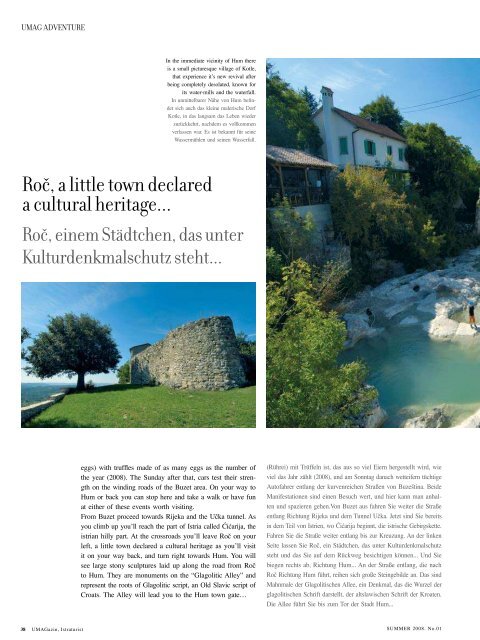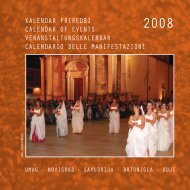UMAG SPOTLIGHT Umag / UMAG EDITORIAL Istrian Villas ... - Istra
UMAG SPOTLIGHT Umag / UMAG EDITORIAL Istrian Villas ... - Istra
UMAG SPOTLIGHT Umag / UMAG EDITORIAL Istrian Villas ... - Istra
Sie wollen auch ein ePaper? Erhöhen Sie die Reichweite Ihrer Titel.
YUMPU macht aus Druck-PDFs automatisch weboptimierte ePaper, die Google liebt.
<strong>UMAG</strong> ADVENTURE HUM<br />
In the immediate vicinity of Hum there<br />
is a small picturesque village of Kotle,<br />
that experience it’s new revival after<br />
being completely desolated, known for<br />
its water-mills and the waterfall.<br />
In unmittelbarer Nähe von Hum befindet<br />
sich auch das kleine malerische Dorf<br />
Kotle, in das langsam das Leben wieder<br />
zurückkehrt, nachdem es vollkommen<br />
verlassen war. Es ist bekannt für seine<br />
Wassermühlen und seinen Wasserfall.<br />
Roč, a little town declared<br />
a cultural heritage...<br />
Roč, einem Städtchen, das unter<br />
Kulturdenkmalschutz steht...<br />
eggs) with truffles made of as many eggs as the number of<br />
the year (2008). The Sunday after that, cars test their strength<br />
on the winding roads of the Buzet area. On your way to<br />
Hum or back you can stop here and take a walk or have fun<br />
at either of these events worth visiting.<br />
From Buzet proceed towards Rijeka and the Učka tunnel. As<br />
you climb up you’ll reach the part of Istria called Ćićarija, the<br />
istrian hilly part. At the crossroads you’ll leave Roč on your<br />
left, a little town declared a cultural heritage as you’ll visit<br />
it on your way back, and turn right towards Hum. You will<br />
see large stony sculptures laid up along the road from Roč<br />
to Hum. They are monuments on the “Glagolitic Alley” and<br />
represent the roots of Glagolitic script, an Old Slavic script of<br />
Croats. The Alley will lead you to the Hum town gate…<br />
(Rührei) mit Trüffeln ist, das aus so viel Eiern hergestellt wird, wie<br />
viel das Jahr zählt (2008), und am Sonntag danach wetteifern tüchtige<br />
Autofahrer entlang der kurvenreichen Straßen von Buzeština. Beide<br />
Manifestationen sind einen Besuch wert, und hier kann man anhalten<br />
und spazieren gehen.Von Buzet aus fahren Sie weiter die Straße<br />
entlang Richtung Rijeka und dem Tunnel Učka. Jetzt sind Sie bereits<br />
in dem Teil von Istrien, wo Ćićarija beginnt, die istrische Gebirgskette.<br />
Fahren Sie die Straße weiter entlang bis zur Kreuzung. An der linken<br />
Seite lassen Sie Roč, ein Städtchen, das unter Kulturdenkmalschutz<br />
steht und das Sie auf dem Rückweg besichtigen können... Und Sie<br />
biegen rechts ab, Richtung Hum... An der Straße entlang, die nach<br />
Roč Richtung Hum führt, reihen sich große Steingebilde an. Das sind<br />
Mahnmale der Glagolitischen Allee, ein Denkmal, das die Wurzel der<br />
glagolitischen Schrift darstellt, der altslawischen Schrift der Kroaten.<br />
Die Allee führt Sie bis zum Tor der Stadt Hum...<br />
Hum<br />
Here we are, in Hum, a little place bearing<br />
the title of the smallest city in the world.<br />
According to the legend, Hum was built with the stones left<br />
over when giants were building towns in the river Mirna valley.<br />
It is situated in the centre of Istria with barely 20 inhabitants.<br />
Despite such a small number of residents it preserved the old<br />
ritual “Election of the prefect for a year” when all the men<br />
from the parish gather at the Municipal Loggia to elect the<br />
village superior by carving their votes into a wooden stick.<br />
Inside the preserved city walls there are two small streets with<br />
three rows of houses. Today, Hum is a city-monument, one of<br />
the rare examples of the urban development within the city<br />
walls. Apart from being famous for being the smallest city<br />
in the world, recently it became popular for “biska”, brandy<br />
Glagolitic Alley Die Glagolitische Allee<br />
The Glagolitic Alley is 7 km long and leads from Roč to Hum. It comprises 11<br />
commemorative headstones representing the development and Croatian roots of<br />
the Glagolitic script, especially in Istria. It starts with “The column of the Chakavian<br />
gathering”, erected in 1977. The commemorative headstones are lying along<br />
the road all the way to Hum, the last monument being the town gates. The gates<br />
are made of copper, with two wings which are very heavy and ornamented with<br />
twelve medallions with scenes from everyday village life, with ox-horn shaped<br />
handles and the door-knockers with welcoming words inscribed in them.<br />
Die Glagolitische Allee ist 7 km lang, führt von Roč nach Hum und umfasst 11<br />
Denkmale, die die Entwicklung und die geschichtlichen Wurzeln der glagolitischen<br />
Schrift bei den Kroaten darstellen, besonders in Istrien. Die Allee beginnt an der<br />
Säule der Čakavischen Volksversammlung, die im Jahre 1977 aufgestellt wurde.<br />
Weiterhin angereiht sind Denkmale entlang der Straße bis ganz nach Hum, und<br />
in Hum endet sie mit dem letzten Denkmal – dem Stadttor. Das Tor von Hum<br />
ist aus Kupfer, zweiflüglig, schwer, festlich. Die Türklinken haben die Form von<br />
Ochsenhörnern, und am Türklopfer stehen Willkommensworte. Im oberen Teil sind<br />
im Halbkreis zwölf Medaillons mit Szenen aus dem Dorfleben aufgestellt.<br />
Hum<br />
Nun sind wir am Ziel angekommen, in Hum, dem Städtchen,<br />
das sich mit dem Beiwort der kleinsten Stadt der Welt rühmt.<br />
Der Legende nach enstand Hum, als die Riesen die Städte im Tal<br />
von Mirna erbaut haben, und aus den restlichen Steinen haben sie<br />
zuletzt Hum erbaut. Es befindet sich in Zentralistrien und hat gerade<br />
noch etwa 20 Einwohner. Trotz der kleinen Einwohnerzahl von<br />
Hum, blieb bis zum heutigen Tage die Tradition der “jährlichen Wahl<br />
des Gespans“ erhalten, einem Akt, wobei alle Männer der Stadt den<br />
Dorfvorsteher wählen, und zwar so, dass sie ihre Stimmen in einen<br />
Holzstab einritzen. Innerhalb der Stadtmauer liegen zwei kleine<br />
Gassen und drei Häuserreihen. Hum ist heute eine Denkmalstadt,<br />
eines der selten erhaltenen Beispiele urbaner Entwicklung innerhalb<br />
der Stadtmauer. Außer seiner Bekanntheit als die kleinste Stadt<br />
der Welt ist Hum seit kurzem auch bekannt als Stadt des istrischen<br />
8 <strong>UMAG</strong>azin, <strong>Istra</strong>turist SUMMER 2008. No.01 No.01. SUMMER 2008. <strong>Istra</strong>turist, <strong>UMAG</strong>azin

















